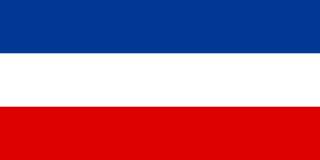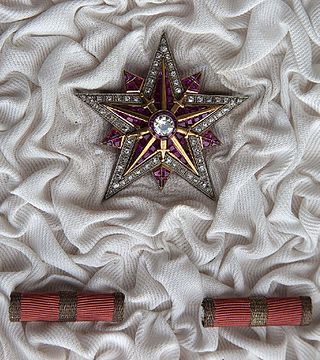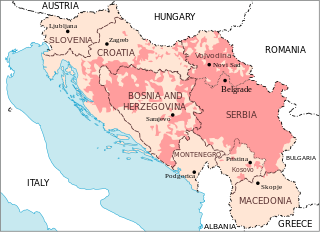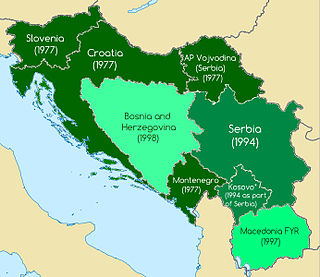
Serbia and Montenegro, known until 2003 as the Federal Republic of Yugoslavia, FR Yugoslavia or simply Yugoslavia, was a country in Southeast Europe located in the Balkans that existed from 1992 to 2006, following the breakup of the Socialist Federal Republic of Yugoslavia. The country bordered Hungary to the north, Romania to the northeast, Bulgaria to the southeast, North Macedonia to the south, Croatia and Bosnia and Herzegovina to the west, and Albania to the southwest. The state was founded on 27 April 1992 as a federation comprising the Republic of Serbia and the Republic of Montenegro. In February 2003, it was transformed from a federal republic to a political union until Montenegro seceded from the union in June 2006, leading to the full independence of both Serbia and Montenegro.

The national flag of Montenegro has a red field with gold border and the coat of arms of Montenegro in its center. It was officially adopted on 13 July 2004, when the then Republic of Montenegro was a constituent of the State Union of Serbia and Montenegro, and its precise specification was standardized on 16 September 2004. The flag was retained after Montenegrin independence from Serbia in 2006, and mandated by Article 4 of the Constitution of Montenegro adopted in 2007.

The President of Serbia and Montenegro was the head of state of Serbia and Montenegro. From its establishment in 1992 until 2003, when the country was reconstituted as a confederacy via constitutional reform, the head of state was known as the President of the Federal Republic of Yugoslavia. With the constitutional reforms of 2003 and the merging of the offices of head of government and head of state, the full title of the president was President of Serbia and Montenegro and Chairman of the Council of Ministers of Serbia and Montenegro. In 2006 the office was abolished as the state union was dissolved, with Serbia and Montenegro becoming independent countries and was followed by Kosovo in 2008 although it received limited international recognition.
Unique Master Citizen Number is an identification number that was assigned to every citizen of former Yugoslav republics of the SFR Yugoslavia. It continues to be used in almost all of the countries that were created after the dissolution of Yugoslavia – Bosnia and Herzegovina, Montenegro, North Macedonia, Serbia and Slovenia use it in its original form, while Croatia has switched to a new identification number called the Personal Identification Number.

The Order of the People's Hero or the Order of the National Hero, was a Yugoslav gallantry medal, the second highest military award, and third overall Yugoslav decoration. It was awarded to individuals, military units, political and other organisations who distinguished themselves by extraordinary heroic deeds during war and in peacetime. The recipients were thereafter known as People's Heroes of Yugoslavia or National Heroes of Yugoslavia. The vast majority was awarded to partisans for actions during the Second World War. A total of 1,322 awards were awarded in Yugoslavia, and 19 were awarded to foreigners.

The system of honours of the Republic of Croatia was established after the independence of Croatia in 1991. There are nineteen main decorations conferred since 2019, in addition to several other medals and awards.

The Order of the White Eagle was a state order in the Kingdom of Serbia (1883–1918) and the Kingdom of Yugoslavia (1918–1945).

Socialist-style emblems usually follow a unique style consisting of communist symbolism. Although commonly referred to as coats of arms, most are not actually traditional heraldic achievements. Many communist governments purposely diverged from heraldic tradition in order to distance themselves from the monarchies that they usually replaced, with coats of arms being seen as symbols of the monarchs.

Orders, decorations, and medals of the Socialist Federal Republic of Yugoslavia were created during the Second World War and used throughout the existence of the Socialist Federal Republic of Yugoslavia. The first decorations were created by AVNOJ on August 15, 1943 and included the Order of the People's Hero, Order of the People's Liberation, Order of the Partisan Star, Order of the Brotherhood and Unity, Order for Bravery and Medal for Bravery. By 1960 the total number of decorations increased to 42 and consisted of 35 orders, 6 medals and 1 commemorative medal. The designers of the Yugoslav orders and medals were Antun Augustinčić and Đorđe Andrejević Kun.

The former State Union of Serbia and Montenegro was represented at the Olympic Games on six occasions between 1996 and 2006, when the union was dissolved and Montenegro and Serbia each declared full independence.
The orders, decorations, and medals of the Kingdom of Yugoslavia were inherited from the Kingdom of Serbia and also established during the Kingdom of Yugoslavia period from 1918 to 1945.

Order of Freedom was the highest military decoration awarded in Yugoslavia, and the second highest Yugoslav state decoration after the Yugoslav Great Star. It was awarded to the commanders of large military units for skillful leadership and for the outstanding courage of the troops. It was awarded to both Yugoslavian and foreign military commanders, and was the most rarely awarded of all Yugoslavian orders, decorations, and medals, being awarded only 7 times before the breakup of Yugoslavia.
State decorations of the Republic of Serbia are regulated by the 2009 Law on Decorations.

From August 1990 to November 1991, during the breakup of Yugoslavia, several Serb Autonomous Regions, or Districts were proclaimed in the Yugoslav republics of SR Croatia and SR Bosnia and Herzegovina in light of the possible secession of the republics from the Socialist Federal Republic of Yugoslavia. These were autonomous Serb-inhabited entities that subsequently united in their respective republic to form the Republic of Serbian Krajina in Croatia and the Republika Srpska in Bosnia and Herzegovina.

The Order of the War Banner was the 7th highest military decoration of the Socialist Federal Republic of Yugoslavia (SFRY), and awarded to "military commanders who show personal courage, self-sacrifice, involvement in commanding and distinct role in creation, fixing and training of Armed Forces of SFRY during the war".

Homosexuality in Yugoslavia was firstly decriminalized in the Socialist Republics of Croatia, Slovenia, Montenegro and the Socialist Autonomous Province of Vojvodina in 1977. In other regions anti-LGBT legislation was, to varying degrees, progressively not implemented. The capital city of Belgrade, together with Zagreb and Ljubljana, became some of the first spots of an organized LGBT movement in the Balkans.

The Constitutional Act on the Rights of National Minorities in the Republic of Croatia is constitutional law which defines rights of national minorities in Croatia. It is one of in total three Constitutional Acts in the Croatian legal system, with the other two being the Constitutional Act on Implementation of the Constitution of Croatia and the Constitutional Act on the Constitutional Court of Croatia. In its current form, the Act entered into force on 23 December 2002. Its earlier version, under the title Constitutional Act on National and Ethnic Communities or Minorities was passed in December 1991 as a precondition of the international community for the recognition of Croatian independence from the Socialist Federal Republic of Yugoslavia. The Act is hierarchically under the Constitution of Croatia and must comply with it, but above ordinary state laws and decisions, and above statutes and decisions of lower levels of government, which all must be in accordance with this law. Additionally, two special laws were created to define rights regarding education in minority languages and specific rights on the usage of minority languages in public life. Additionally, the Constitution of Croatia itself has articles directly relating to the protection of national minorities, and lists traditional minorities in Croatia.
Order of Military Merits was a state decoration awarded in Yugoslavia, divided into three classes. It was awarded to commanders of units and civilians serving in the Yugoslav People's Army, as well as individuals in trade unions or other organizations with outstanding contributions and accomplishment of tasks of special immediate importance for national defense.

The Agreement on Succession Issues of the Former Socialist Federal Republic of Yugoslavia is an international agreement on shared state succession of the Socialist Federal Republic of Yugoslavia reached among its former constituents republics following the breakup of the country in early 1990s.

Order of Yugoslavia was the highest national order of merit awarded in Serbia and Montenegro between 1998 and the dissolution of the Union in 2006. It was intended to be awarded to heads of states and governments, in two variants: on grand collar or on sash.















